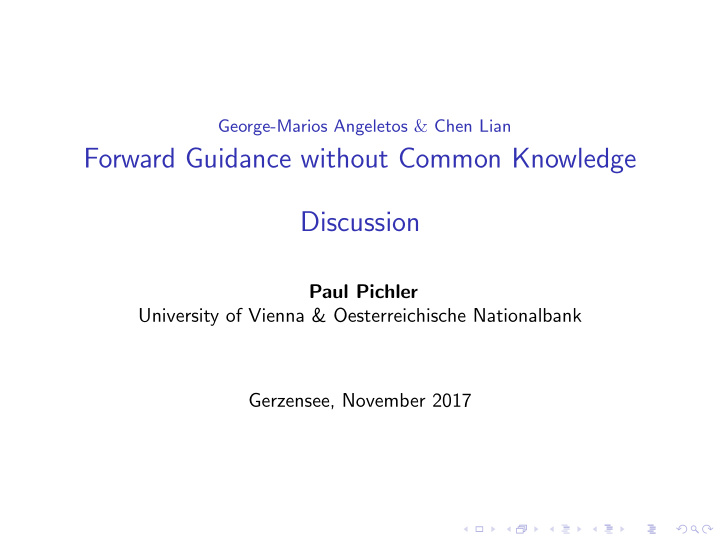



George-Marios Angeletos & Chen Lian Forward Guidance without Common Knowledge Discussion Paul Pichler University of Vienna & Oesterreichische Nationalbank Gerzensee, November 2017
Main contributions • Dynamic Beauty Contests • Aggregate outcomes today depend positively on expectations of aggregate outcomes tomorrow • Removing common knowledge attenuates reaction of expectations of future outcomes to current news at a rate that increases with the horizon of the news • As if agents discounted future more heavily • Removing the ”common knowledge” assumption from the New Keynesian model 1) solves the Forward Guidance Puzzle, 2) reduces the Paradox of Flexibility (Eggertson and Krugman, 2012), 3) offers a rationale for the front-loading of fiscal stimuli.
FGP / PoF • Dynamic IS and NKPC in standard NK model (Gali, 2008): y t = − σ E t r t +1 + E t y t +1 π t = κy t + β E t π t +1 • Iterating on the dynamic IS curve yields y t = − σ E t r t +1 + E t {− σ E t +1 r t +2 + E t +1 y t +2 } = − σ ( E t r t +1 + E t E t +1 r t +2 ) + E t E t +1 {− σ E t +2 r t +3 + E t +2 c t +3 } = ... • Under complete information, Law of Iterated Expectations implies ∞ ∞ � � y t = − σ E t r t + k = − σ E t { i t + k − π t + k +1 } k =1 k =0
FGP / PoF • Partial effect of increase in E t π t + s on y t is equal to σ , independent of horizon s • Additional general equilibrium effects via inflation expectations (NKPC). For example, for s = 2 : dy t ∂y t ∂y t d E t π t +1 = + d E t π t +2 ∂ E t π t +2 ∂ E t π t +1 d E t π t +2 ∂y t ∂y t � ∂ E t π t +1 ∂ E t y t +1 + ∂ E t π t +1 � = + ∂ E t π t +2 ∂ E t π t +1 ∂ E t y t +1 ∂ E t π t +2 ∂ E t π t +2 = σ (1 + κσ + β ) > σ Assumption: nominal rates kept constant (e.g., liquidity trap) • Total effect increases in the ... • announcement horizon, s : Forward Guidance Puzzle • price flexibility, κ : Paradox of Flexibility
Role of CK • Extensive use of complete information (CK) assumption • to formulate y t as function of expected real interest rate path, • to compute general equilibrium effects • Perfect coordination of beliefs/plans important for amplification effects (dynamic strategic complemetarities) • Angeletos and Lian show that without CK, • general equilibrium effects are substantially attenuated • attenuation larger for larger horizons (solves FGP)
HOB • Higher-order beliefs (HOB) key to the mechanism - Attenuation effect: HOB move less than first-order beliefs - Horizon effect: longer horizons raise relative importance of HOB Longer horizons increase the number of loops from future aggregate actions to current actions. But when one increases the number of loops, one is effectively walking down the hierarchy of beliefs: forecasting outcomes further and further into the future maps to forecasting the forecasts of others at higher and higher orders. This in turn explains why longer horizons increase the relative importance of higher-order beliefs. (p.19) • ... as if each agent is ”myopic” vis-a-vis the future aggregate dynamics (p.3)
Policy lessons and questions • Backloading monetary / fiscal stimulus into the distant future does not boost current economic activity without bounds • Even when promises are perfectly credible • Probably no news for policy-makers • Reconsider the role of models for policy-making • Commonly accepted (but still unrealistic) assumptions, e.g. complete information, can have enormous effects on models’ optimal policy prescriptions • What is the right framework to study effects of forward guidance? • More efforts to assess robustness needed • Coordination of individual beliefs/plans important for the transmission of macroeconomic policies • Should policy-makers try to improve coordination of beliefs? Try to streamline beliefs (to get closer to CK)? E.g., fight heterogeneity in inflation expectations?
Evaluation • Great paper! ”Solves” FGP not by adding assumptions (e.g., liquidity constraints) to the standard NK model, but by relaxing one key (strong) assumption of this model (CK) • Results derived in very general environment (DBC), hence paper goes far beyond ”only” solving the FGP • Not an easy read: many theoretical results, general framework versus forward guidance application, ... probably difficult to find perfect structure • One last question: Is the NK model without CK still able to generate a deflationary spiral / severe recession during a liquidity trap? (see your FN 6) And if not, how should we interpret the role of CK then?
Recommend
More recommend